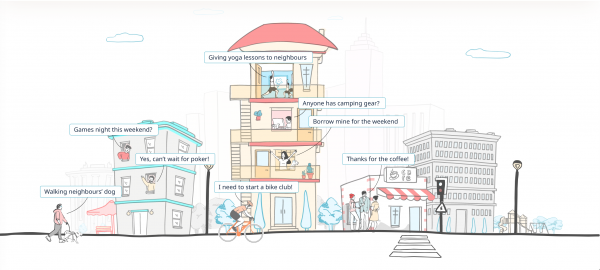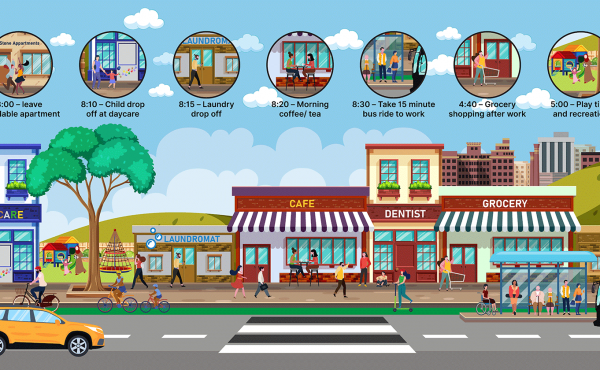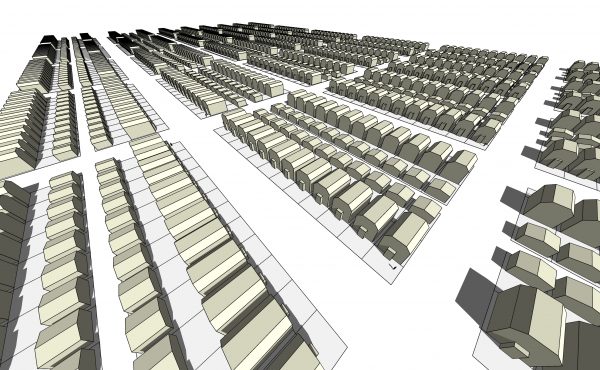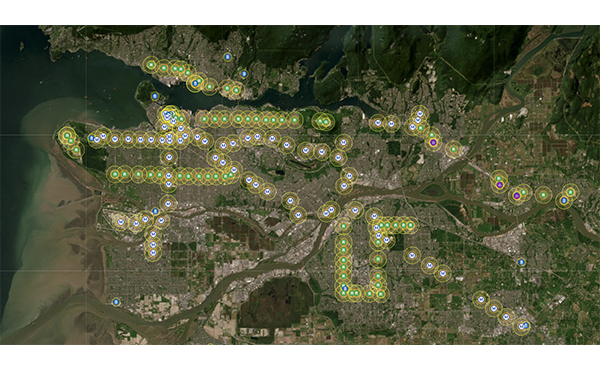
[EDITOR’S NOTE: It is with the heaviest heart that we at Spacing Vancouver inform readers of the unexpected passing of Ulduz Maschaykh. Known to friends and family as Ulee, she was a regular contributor and covered a diversity of topics. An avid advocate against the growing inequalities in our city—particularly around housing affordability—her love of Vancouver was everpresent. This love, in fact, was the foundation of her advocacy and led to her moving halfway around the world to live here and attempt to improve the place within which we live.
The readers of her work on Spacing Vancouver were ultimately the beneficiaries and the interview you are about to read is yet another example of her commitment to contributing positively to the evolution of Vancouver—focusing, in this case, on the important issue of loneliness in the city. Ulee and her contributions will be deeply missed. We are honoured that she chose Spacing Vancouver as her outlet of change and are glad to be the repository of her excellent work.
****
Saif Khan is the co-founder of the Vancouver-based research lab Hangeh. Recently, Spacing contributor Ulduz Maschaykh had the pleasure of sitting down with him to talk about the growing trend of loneliness in our cities and the importance of design for inclusive communities and social connectedness.
UM: Can you tell us about yourself and your company Hangeh?
SK: Hangeh is a property technology platform that started in August 2021. I started it with two of my childhood friends. Each of us brings in a different perspective and skillset. To give some context, I have worked in real estate finance with a focus on multifamily residential investments, while the other 2 co-founders have backgrounds in digital products and live event operations, respectively. We build digital tools and life experiences that address urban isolation for multi-family housing and urban high-rise buildings. Over the last few years, isolation has become a growing concern, largely due to the physical, mental and social health costs associated with it.
My co-founders and I all grew up in Pakistan. We all grew up around a very strong sense of community. We would always feel safe in our neighbourhood. There are a lot of communities around the world that are very engaged without many resources, as they are more resilient.
The idea for Hangeh started when I was living in a high-rise building in Toronto and experienced the lack of sense of community there. So we did some user testing and did some simple prototypes with the goal to get people in buildings to be more engaged and involved with each other and organize events to help people feel less lonely. It was an initial success. We are still in our early stages but we are working with developers, especially in downtown Vancouver and in East Vancouver to implement this approach.
UM: Who are your clients?
SK: Urban high-rise buildings, developers and property management teams. For local partnerships, we are exploring all sorts of small and large businesses. We focus on independently owned businesses, charities and local causes. We integrate three main pieces of resident engagement:
- Offering residents’ events and programming that are tailored to the demographic and cultural context of the residents.
- Providing digital interfaces. For a lot of buildings we found out that there are no technological or communication tools available. There is a lot of opportunities to engage digital experiences in that situation.
- Enabling local, economic ecosystems. This means we are trying to find a way for residents of a building to support local businesses, as they have been challenged since 2020. We provide a platform for neighbourhood businesses to advertise their businesses and offer discounts.
UM: How do you reach out to the charities in the community?
SK: We go to local community organizations such as libraries and social services. There are also a lot of developers and people in the construction industry who want to support local causes in the communities they are building in, but they don’t know how to support the community. We help them to find the right charities and communities in a more transparent way.
UM: What is the incentive for a developer to donate money to a charity?
SK: There are a lot of companies that are committed to supporting the communities they operate within. The local municipal office also usually requires developers to provide long-term commitment and stewardship which for the municipal approvals process requires contributions to the local community with amenities.
UM: Why would it matter to a developer or building owner to have the residents of their buildings be socially connected?
SK: It would be hard to describe the incentive if you just look at the monetary aspect. At the end of the day, residents are customers. What has changed after COVID though is the perception of developers on what they have to offer to residents. They have to adapt to changing customer preferences and, after 2020, those preferences have evolved in many ways. Now residents have different needs. The market has changed in terms of what the demand is, particularly around the issue of social isolation. Loneliness is a problem that cannot be ignored anymore. That is a real resident experience problem and developers need to address it.
Hangeh’s approach has received a good response. Their return on investment is higher when they focus on the customer experience, tackling social isolation and creating a sense of community. There is a commitment on the side of the developers to invest more in creating inclusive communities for their residents.
UM: What is the incentive for developers in economic terms?
SK: A building by itself needs so many service providers. But developers have a hard time finding the right fit or negotiating properly. One of the biggest opportunities for developers and building managers is how they can get better terms for services that a very large population needs.
The other part of the incentive for developers is that providing their tenants and buyers with services is now a branding exercise. In order for them to adapt to the needs of their customers, developers need to find the things that the customers need.
There is really a growing need to provide these services and the more we look into it, the more we discover the necessity of it. Despite this need, social isolation is not a topic that is well-reported and we want to change this.
We are trying to start such conversations through our blog, podcast and using our platform to promote all organizations working hard to create an impact within the urban housing space.
UM: Let’s talk about Optimized Spaces for Social Connection: How does one optimize the design of residential spaces in order to optimize social connections and build resilient communities?
SK: Resident experience itself can be divided across experience as a user or what physical spaces can be like. The architecture of buildings plays a huge role in how spaces can be designed to foster human connection and provide interaction points. Overall, I am not passing this on as a general criticism, but sometimes there are multi-million dollar developments that still lack emphasis on residents’ experiences or inclusive design. If you look at the economics of these developments, the focus only goes on optimizing the leasable square footage. That is part of the problem.
Our approach is to overcome the physical limitations of architecture. If you have a good range of alternative interspaces and one knows how people can interact with each other—maximizing the opportunity—our bet is that it would happen. Interestingly, we found out that the more integrated the local businesses are in the neighbourhood, the more you can share things and integrate local amenities. The local park is no different from someone’s backyard. If you have the right mix of people to gather within it, it can be a strong communal space.
Our goal is to also improve social infrastructure, that is public spaces. We facilitate this by enabling booking events through user experience like any other digital platform. I believe you only need to have a meaningful interaction with someone new once or twice and then you can find a friend for life. One of the things we found out is that about 70% of multi-family residents know 3 or fewer neighbours as friends. That is an alarming statistic that goes across Canada.
Over the last 40-60 years, levels of residential density in urban spaces has moved in an inverse correlation with levels of connectedness within communities. Partly due to the paradox of social media, people’s perceived sense of connectedness and community has also been displaced within virtual and physical spaces. With the whole digitized lives that we live now, it is easy for people to overestimate how connected they actually really are.
Especially during the pandemic, we need actual people who are physically around us and who we can trust, such as good neighbours. So these statistics about social connectedness are very alarming. And they are from places that have some of the most expensive real estate in the world. Clearly, this is not a demand and supply problem. People are realizing that the community needs to get involved and I think the industry has not done a good job in promoting this realization.
UM: But isn’t that a contradiction: You mention that our digitalized era is isolating us more and more, and yet at the same time, the work that Hangeh does is offering solutions through digitalization.
SK: That is something we did think about. Our goal is to have a digital interface only as far as it creates efficiency in the discovery process. What I mean by that is that even though we do criticize social media platforms, one thing they are good at doing is facilitating the process of localized discovery and interactivity. So, if I want to wake up and know all the local businesses that are around me, or if my neighbour is selling furniture that I happen to need, that experience can create a meaningful interaction. That is the extent to which we want to use technology.
One of the core tenets of our platform is to be partial towards experiences or events that encourage in-person interactions. We don’t have any ads on our app. I think you should not use the problem to address the solution. Facebook, Instagram and other giant tech companies whose business model is built around the attention economy, are unfortunately part of the reason the problem of social isolation is quickly getting out of control. The other part is privacy: it’s a very sensitive situation for people in their intimate interaction with each other within their living surroundings. We made a very critical choice with privacy and self-contained data is at the core of our values. We don’t sell people’s information to third parties and we don’t use any ads.
UM: Do you think your services would be adequate for non-profit services that serve the homeless population?
SK: We have had a lot of interest from grassroots organizations, research institutions and non-profits. We have been part of CMHC’s Solutions Lab and also support non-profit organizations. For example, right now we are helping one of the participants of the Solutions Lab—they are called Greener Village in New Brunswick—to use our resources to connect a network of local non-profits and community service providers so that people with special needs can be provided support and resources easily.
Our goal is to support everyone. We would love to see our services with an ecosystem for as many people as possible. This will also help develop our services more. Especially fighting homelessness. One of our pilot programmes is on how resident contributions and resident funds can contribute to causes for the homeless.
We would love to also work with academic institutions and support research. Our internal market research efforts have included user surveys, interest groups etc. with a sample size in excess of 1000 urban residents. We started this research in early 2021 with multi-family residents. Our surveys measured perceived satisfaction with the resident experience. It covered the above-average luxury and premium segment. Sixty percent of multi-family residents stated that the ideal amenities are the ones that foster social connections and shared experiences. People find a lot more meaning in spending money when it makes them feel good.
A report showed that between 2019 and 2021 up to 60% of Gen Z and Millennials have anxiety and depression. And this statistic is up by more than 3 times in less than 2 years —which, to us, is really alarming. That is a stigma and people are not yet willing to admit it. This shows us that clearly there is something that physician spaces are not doing to capture this problem.
UM: To what extent can digital tools help foster social connections?
SK: I see the role of digital technology to be limited to making the discovery part easier. Even though it is a slight paradox, Hangeh is classified as a property technology company, for most of the part. But I also equally see digital tools having a limited role. It should be limited, especially as far as personal interactions are concerned and how necessary this is for physical, emotional and mental well-being. Video conference tools are a good example of how you can use technology for bringing people together, making them feel as though they are together. But it should not go beyond being efficient or attempting to take over the activity itself. That is what we are trying to bring back.
Physical proximity does play a big role: like when you walk someplace within 5 mins and spontaneous interactions happen. Starting with a simple, good conversation you can develop a really good friendship in a relatively short amount of time.
Statistically, it’s said that 70% of people stated they don’t have anyone to rely on. So, we may be able to fix this situation with proximity and physical infrastructure. We would love to work with more non-profits and grassroots organizations on towards that end!
****
For more information on Hangeh, visit the website.
**
Ulduz Maschaykh was an art/urban historian with an interest in architecture, design and the impact of cities on people’s lives. Through her international studies in Bonn (Germany), Vancouver (Canada) and Auckland (New Zealand) she has gained a diverse and intercultural understanding of cultures and cities. She is the author of the book, “The Changing Image of Affordable Housing – Design, Gentrification and Community in Canada and Europe”.





One comment
Ulee will be dearly missed. Her charisma and work ethic could not be matched. Vancouver won’t be the same without her.